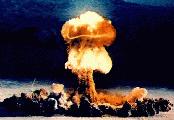





The proliferation of missile technology was the ostensible rationale used by the Bush Administration for the Strategic Defense Initiative. Defense Secretary Richard Cheney claimed in 1991 that "As Iraq has shown, modern technology can make a third-rate power a first-class military threat. By the year 2000, more than two dozen developing nations will have ballistic missiles . Iraq is only one of many countries that now have or will soon acquire these kinds of sophisticated capabilities. The trend is also towards missiles with increased new long ranges. Combined with chemical, biological and nuclear weapons these missile can be vehicles of terror, aggression and intimidation. Who wants to be foolish enough to stake our nation's future on the belief that these weapons will never be used . Because of our global interests, a Third World missile strike can be a danger even when it doesn't reach our shores. Friends, allies, trading partners and strategic resources can all be in range of ballistic missile threats.." (1)
The present Republican-led 104th Congress adopted essentially the same rationale for a national ballistic missile defense in the Defend America Act of 1996. Section 2 (2) of the proposed act states "The threat that is posed to the national security of the United States is significant and growing, both quantitatively and qualitatively." To assess whether this is the case requires an up-to-date examination of the state of ballistic missile proliferation among the countries of the world.
During and since the Bush Administration, estimates of the number of prospective ballistic missile states -- ranging from 15 to 25 by the year 2000 -- have been used by advocates of missile defenses to win support for their position. (2) These missiles generally fall into four categories:
The spread of ballistic missiles and other advanced weapons is an extremely important problem facing the international community, and the U.S. should take strong steps to stem such proliferation. An examination of this list of current and potential ballistic missile states and their capabilities should take into account (1) whether they are hostile to the U.S., (2) their current missile deployments, (3) their indigenous technical capabilities, and (4) their ability to purchase hardware and/or expertise.
1. Dick Cheney,"News Briefing on FY92 Defense Budget," Feb. 4, 1991.
2. Steven Hadley, Assistant Secretary of Defense for International and Security Policy, stated that 18 countries currently have ballistic missile capability, and that number will rise to about 24 by the year 2000 (Joint DOD/SDIO briefing on GPALS, Feb. 12, 1991); Thomas Brooks, Chief of Naval Operations, stated that "By the year 2000, at least 15 Third World countries are expected to have acquired TBMs" (Testimony before HASC on Intelligence Issues, March 7 1991); William Webster, Director of Central Intelligence, stated that by the year 2000 "as many as 15 countries could be producing their own ballistic missiles" (Speech at Amherst Association of New York, May 22, 1991). Webster's speech writer later clarified that the 15 countries are worldwide, and not just in the Third World (private communication).
